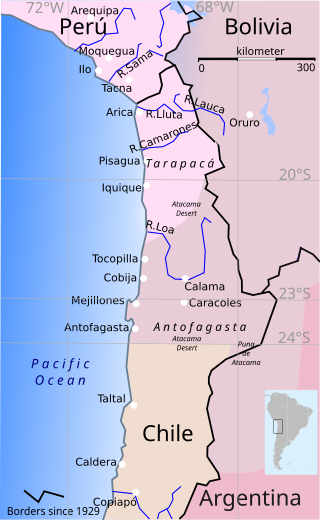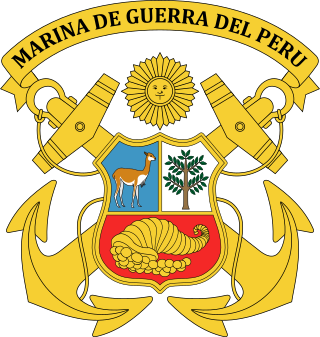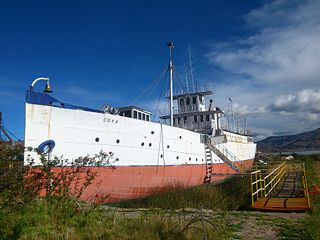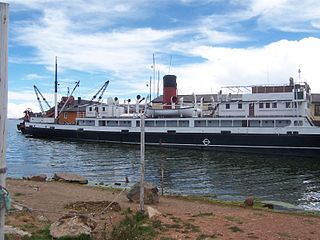This article describes the transport in Peru.

Lake Titicaca is a large freshwater lake in the Andes mountains on the border of Bolivia and Peru. It is often called the highest navigable lake in the world. Titicaca is the largest lake in South America both in terms of the volume of water and surface area. It has a surface elevation of 3,812 m (12,507 ft).

The War of the Pacific, also known as the Nitrate War and by multiple other names, was a war between Chile and a Bolivian–Peruvian alliance from 1879 to 1884. Fought over Chilean claims on coastal Bolivian territory in the Atacama Desert, the war ended with victory for Chile, which gained a significant amount of resource-rich territory from Peru and Bolivia.

The Peruvian Navy is the branch of the Peruvian Armed Forces tasked with surveillance, patrol and defense on lakes, rivers and the Pacific Ocean up to 200 nautical miles from the Peruvian littoral. Additional missions include assistance in safeguarding internal security, conducting disaster relief operations and participating in international peacekeeping operations.

Puno is a department and region in southeastern Peru. It is the fifth largest department in Peru, after Cuzco, Madre de Dios, Ucayali, and Loreto. It is bordered by Bolivia on the east, the departments of Madre de Dios on the north, Cusco and Arequipa on the west, Moquegua on the southwest, and Tacna on the south. Its capital is the city of Puno, which is located on Lake Titicaca in the geographical region known as the Altiplano or high sierra.

The Thames Ironworks and Shipbuilding Company, Limited was a shipyard and iron works straddling the mouth of Bow Creek at its confluence with the River Thames, at Leamouth Wharf on the west side and at Canning Town on the east side. Its main activity was shipbuilding, but it also diversified into civil engineering, marine engines, cranes, electrical engineering and motor cars.

Yavari is a British-built iron steamship commissioned by the Peruvian government in 1861 for use on Lake Titicaca by the Peruvian Navy.

PeruRail is a railway operator providing tourist, freight, and charter services in southern Peru. It was founded in 1999 by two Peruvian entrepreneurs and the British company Sea Containers.

Rail transport in Peru has a varied history. Peruvian rail transport has never formed a true network, primarily comprising separate lines running inland from the coast and built according to freight need rather than passenger need.
Earle's Shipbuilding was an engineering company that was based in Hull, East Riding of Yorkshire, England from 1845 to 1932.
The Morenada is an Andean folk dance whose origins are still under debate. This dance is practiced mainly in Bolivia as well as in Peru and in recent years with Bolivian immigration in Chile, Argentina and other countries.

SS Coya is a 19th-century iron-hulled steamship on Lake Titicaca in Peru. After a long history carrying freight and passengers she is currently a floating restaurant.
SS Inca was a steamship on Lake Titicaca in Peru.

SS Ollanta, built in England in 1931, is a steamship on Lake Titicaca in Peru.

The introduction of fast torpedo boats in the late 19th century was a serious concern to navies of an era that saw a number of innovations in naval warfare, including the first torpedo boats, which carried spar torpedoes, steam propulsion and steel ships.
Colo Colo was a Colo Colo-class torpedo boat built for the Chilean Navy in 1880. The torpedo boat participated in the War of the Pacific, where it fought in the blockade of Callao and patrolled Lake Titicaca in the final phase of that war.

The Capture of the corvette Pilcomayo was a battle of the Naval campaign of the War of the Pacific. In the battle, the Peruvian gunboat Pilcomayo was captured by the Chilean ironclad Blanco Encalada after a brief confrontation.

Nicolás Federico Portal was a Peruvian captain and politician during the War of the Pacific. He is known for being the captain of the BAP Unión throughout the war.

The Bolivian–Peruvian territorial dispute was a territorial dispute between Bolivia and Peru that lasted from the former's independence in 1825 to the signing of the Polo–Bustamante Treaty in 1909.














